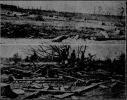True, but the situation with the scale is out of control now.
Somebody PLEASE Fix it!!!! The EF-scale is extremely corrupted.
I think mentality's contributing. IMO Fujita's intent was to discern tornado intensity (hence his use of non-standard indicators), and create damage categories based on a common, relatable structure - the family home. The EF scale comes from a theoretical engineering mentality. Damage is examined and a windspeed is assigned based on the theoretical minimum to cause it. The fullest manifestation of this mindset seems to postdate the EF scale's implementation, as we see greater instance of minimums being used over expecteds, and some surveyors even finding justification to break the bounds of the scale to assign lower windspeeds more recently, and a complete rejection of radar data that didn't apply to Rozel KS but did to everything subsequent.
Two problems arise. Firstly, we can't field test the speeds. While they are based at least partially on empirical data (e.g. wind tunnel tests), tornado wind dynamics are complex and we can't summon up a tornado of fixed intensity to see what actually happens. Secondly, failure would be a probability (don't know what ones they used). That doesn't mean the windspeed wasn't higher when the structure actually failed. If windspeeds are higher then this could make the ASCE hot under the collar as it could imply their standards are suboptimal. The current mentality is based on what windspeeds could be given a set of engineering considerations. If we actually want to understand tornadoes better, I think need to move to a mentality of discerning what the windspeeds
actually are.
That said, any EF scale fix must start with the expected value of frame houses being made EF5 again. The original EF scale proposal gave the equivalent value to F5 as being 200 MPH. As mentioned by John Robinson, it was a personal, political decision of one of those involved in the EF scale to change the threshold, and as said by several posters here there's sound reasons to think Robinson was the one responsible. Aligning the categories with Fujita's original intent - a six step scale based on a common structure - would show an important change in mentality.
Adding to that, that's why I think 'contextual damage' can be a red herring. Firstly, in practice we see it used to downrate but never uprate. Secondly, if the category thresholds are repaired to reflect the original intent of the scale, then an EF5 rating should be able to be assigned to a well constructed house without the context needing initial consideration. This isn't to say it shouldn't be considered, but its currently being crucial to achieving EF5 is partly
because the thresholds were deliberately misaligned.
Eventually I think the tornado rating mentality needs to change to:
1: We want to discern a tornado's windspeed - what tools do we have and how do we apply them? This means ditching the 'damage only' mentality and working out how radar speeds relate to near-ground, and accepting things like the rare direct measurement (is there any reason the 175 mph measurement from the TIV2 on 27/5/13 shouldn't be accepted?). I'm still a big fan of photogrammetry as a possible solution to some questions.
2: how do we align windspeeds to Fujita's original six-step damage categorisation for frame homes of 'good' construction (but not some 'superior' construction never observed in real life) to make a functional scale?
Not 'homes shouldn't be EF5 because that's like my opinion man', which is literally the situation we currently have.
OTOH looking at the IF scale in Europe, they seem to have a sounder and less personally driven basis for their decisions. But I don't like the 'IF2.5' and '3.5' steps. They smack of the false precision of the TORRO scale and are just plain ugly.











